Figure 3. CD49f+/CD44+/CD24− single-cell derived clones retain their characteristics at further passages.
Functional assays were performed using 2 most aggressive (S2B11 and S2G7) and 2 less aggressive (S2D10 and S2F10) clones that were derived from CD49f+/CD44+/CD24− single cells after passage 10. (A) More aggressive clones still formed significantly more and bigger spheres compared to less aggressive clones. Bar scale represents 50 μm. (B) More aggressive clones had significantly higher number of migrated cells compared to less aggressive clones. Bar scale represents 25 μm. (C) More aggressive clones had significantly higher number of invasive cells compared to less aggressive clones. Bar scale represents 25 μm. (D) More aggressive clones had significantly lower global DNA methylation compared to less aggressive clones. (E) More aggressive clones had significantly higher ALDH activity than less aggressive clones. (F) More aggressive (S2B11 and S2G7) and less aggressive (S2D10 and S2F10) clones showed a different pattern of cell cycle. S2B11 and S2G7 had a significantly higher number of cells accumulated in G2 phase compared to S2D10 and S2F10. G, S2B11 and S2G7 cells are more prolific indicated by their higher staining of Ki-67 compared to S2D10 and S2F10 cells. Data represents the mean ± S.D (n = 3); *p < 0.05.

